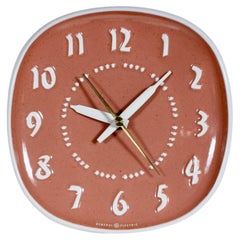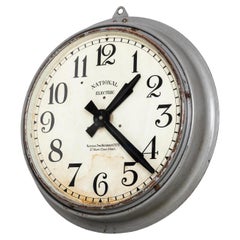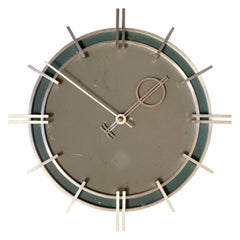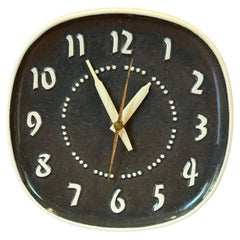Russel Wright Wall Clocks
While industrial designer Russell Wright may be known to modern furniture enthusiasts for his streamlined end tables, dining chairs and other pieces, he is universally revered for a line of tableware he created called American Modern. Efficient, practical, and striking in their elegant forms and warm colors, the American Modern ceramic pieces, which included bowls, pitchers, dishes, and other items, became the best-selling dinnerware of all time. Today, vintage Russell Wright American Modern tableware is an evergreen favorite of art collectors and interior designers alike.
Born in 1904 in Ohio, Wright was surrounded by inspiration for the furniture he would one day design. He was raised in a Quaker household and grew up with the spare, meticulously handcrafted furniture for which the Quakers are known. As a young man, he studied art and sculpture at the Art Academy of Cincinnati and the Art Students League of New York, going on to study law at Princeton University in New Jersey. But Wright loved the arts and abandoned his pursuit of a law degree to create stage sets in Princeton and Paris alongside fellow noted designer Norman Bel Geddes.
In 1927, Wright married artist and sculptor Mary Einstein. Together, they moved to New York City, where Wright began to create sculptures. Mary convinced him to create metal bookends from his sculptures, and later, when he began to craft bar accessories from chrome, he turned to aluminum, a much cheaper material for the purposes of mass production (his barware was eventually included in the "Machine Art" show at the Museum of Modern Art in 1934, which was curated by Philip Johnson).
Mary worked on marketing Russell's products, successfully proposing everyday uses for Wright's beautifully designed housewares. She is said to have been a pioneer in the world of lifestyle marketing, coining the terms "American Modern" and "blonde" to describe the charming, light-colored maple furniture he created for Conant Ball, which was known at the time for its reproductions of American Colonial furniture.
While Wright had created some Art Deco furnishings for Heywood-Wakefield, it was this group of bedroom furniture for Conant Ball that got its name, American Modern, from Mary. Under her guidance, Wright's attractive, functional designs for the home gained renown, leading to commissions by prestigious companies like the Steubenville Pottery Company.
In 1935, Wright formed Russell Wright Associates with Irving Richards, an entrepreneur who had worked with Lightolier and would later establish Raymor. In collaboration with Richards, Wright debuted the first line of American Modern dinnerware in 1939, which was initially produced by Russell Wright Associates and then manufactured by Steubenville for two decades. The line sold over 200 million pieces during its 20 years of production. In 1955, Wright was selected by the U.S. State Department to research handicraft industries in Southeast Asia, a trip that influenced his later designs.
Throughout his life, Wright continued to design furniture and housewares, with the works' signature earth tones, curved forms, and clean silhouettes of his floor lamps, lounge chairs, and serveware remaining popular staples in American households. In his later years, he focused on designing and building his home, Manitoga, and working with the National Parks Service to develop the "Summer in the Parks" program.
Upon Wright's death in 1974, Manitoga was given to the Nature Conservancy. It was declared a National Historic Landmark in 2006 and today houses the Russell & Mary Wright Design Gallery, where many of Wright's works stand on permanent display. In 2011, stamps from the U.S. Postal Service featured Wright's image as one of the United States' twelve most influential industrial designers.
Find vintage Russel Wright lighting, seating, tables, serveware, ceramics and glass on 1stDibs.
1950s American Modern Vintage Russel Wright Wall Clocks
Bronze, Iron
1950s English Industrial Vintage Russel Wright Wall Clocks
Brass
1960s German Mid-Century Modern Vintage Russel Wright Wall Clocks
Brass
1950s German Mid-Century Modern Vintage Russel Wright Wall Clocks
Brass
Mid-20th Century American Mid-Century Modern Russel Wright Wall Clocks
Brass
1960s American Mid-Century Modern Vintage Russel Wright Wall Clocks
Plastic
1930s British Industrial Vintage Russel Wright Wall Clocks
Copper, Steel
1970s German Industrial Vintage Russel Wright Wall Clocks
Aluminum
1960s French Mid-Century Modern Vintage Russel Wright Wall Clocks
Aluminum
1950s German Mid-Century Modern Vintage Russel Wright Wall Clocks
Ceramic, Glass
Early 20th Century Art Deco Russel Wright Wall Clocks
Metal
20th Century Machine Age Russel Wright Wall Clocks
1960s American Mid-Century Modern Vintage Russel Wright Wall Clocks
Aluminum
1940s American Mid-Century Modern Vintage Russel Wright Wall Clocks
Ceramic
Russel Wright wall clocks for sale on 1stDibs.
- What did Russel Wright design?1 Answer1stDibs ExpertMarch 22, 2022Russel Wright designed many things over the course of his life. He is well known for his vibrantly colored American Modern dinnerware produced from 1939 to 1959. Wright also created furniture, lighting and other home accents. Find a range of Russel Wright furniture and decorative accents on 1stDibs.
- 1stDibs ExpertJanuary 27, 2025Russel Wright pottery was made in Steubenville, Ohio, through a partnership with the Steubenville Pottery Company. In 1935, Wright formed Russel Wright Associates with Irving Richards, an entrepreneur who had worked with Lightolier and would later establish Raymor. In collaboration with Richards, Wright debuted the first line of American Modern dinnerware in 1939. Steubenville continued to produce it for two decades. The line sold over 200 million pieces during its 20 years of production. On 1stDibs, find a collection of Russel Wright furniture and tableware.
- Who made Russel Wright pottery?1 Answer1stDibs ExpertJanuary 27, 2025The Steubenville Pottery Company made Russel Wright pottery. Russel Wright was a furniture maker as well as an industrial designer. Steubenville began producing his line of pottery in 1939. Production continued for two decades. On 1stDibs, find an assortment of Russel Wright pottery.



